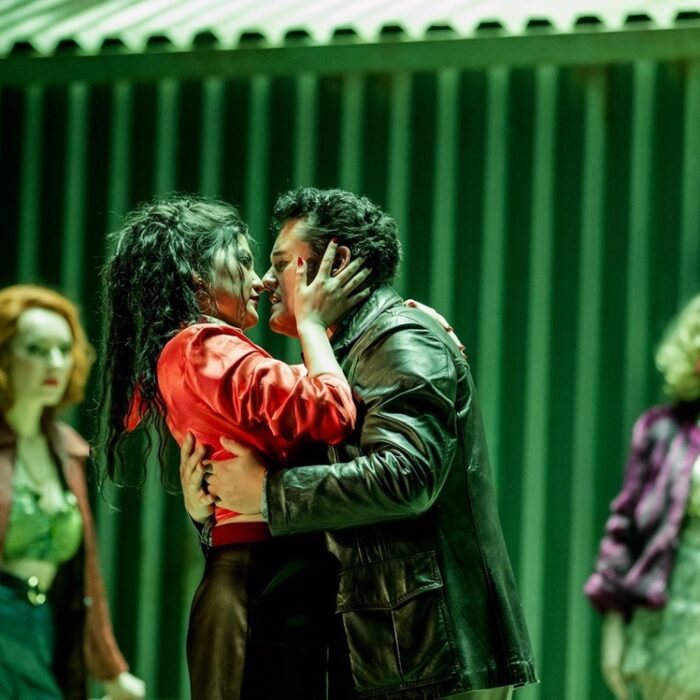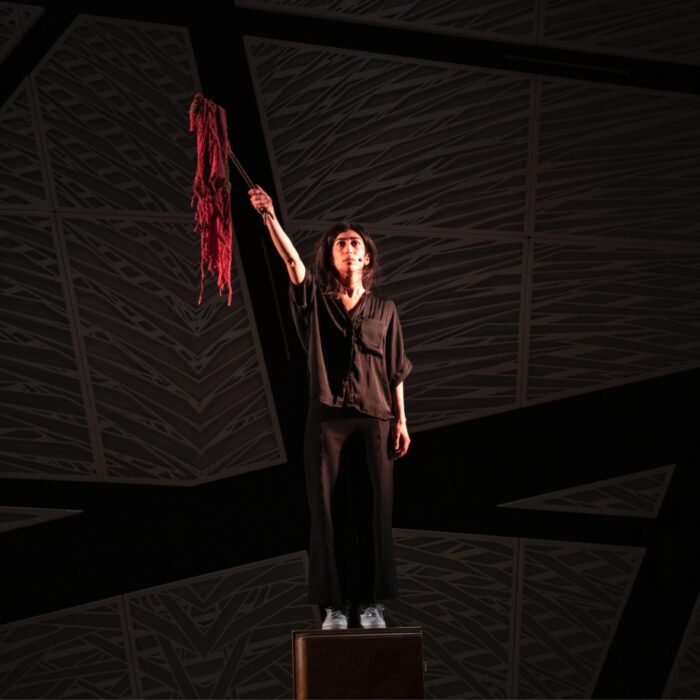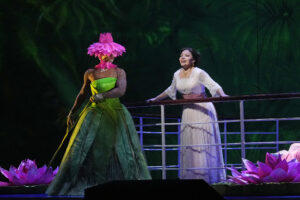
Metropolitan Opera 2023-24 Review: Florencia en el Amazonas
Ailyn Pérez, Gabriela Reyes & Nancy Fabiola Herrera’s Vibrant Turns Soar in Daniel Catán’s Glorious Operatic Love Letter
By David SalazarThe Spanish language is pretty preponderant in the United States of America with a recent census stating that over 42 million people in the country aged five and older speak the language at home. It’s the second most learned language following English, with over 8 million students.
And yet, it took until 2023 for the Metropolitan Opera to finally, and I can’t emphasize finally enough, to think that the Spanish language and a Latin American composer deserved a place on its stage.
“Florencia en el Amazonas” is only the third Spanish-language opera to get a presentation at the Met Opera, but the first two, “Goyescas” and “La Vida Breve” took the stage nearly a century ago. Might as well be a completely different company. And those two works were by Spanish composers. Catán, a Mexican, is the first from a Latin American country. So for millions of people, for the biggest opera company in the world to finally give them a proverbial seat at the table (or moment in the spotlight) is a pretty big deal.
And while the production opened on Nov. 16, the performance on Dec. 5 was packed, indicating that enthusiasm remains high for this work. And that’s for very good reason because “Florencia” shines where most modern operas sink.
All You Need is Love
Composed by Catán and written by Marcela Fuentes-Berain, the opera is notably the first Latin American opera ever commissioned by a opera company in the United States. It premiered in 1996 at the Houston Grand Opera, receiving subsequent performances at the Los Angeles Opera, Seattle Opera, Florida Grand Opera, New York City Opera, Opera Colorado, Arizona Opera, Washington National Opera, and Lyric Opera of Chicago. Internationally, it has also appeared in Mexico, Germany, and Colombia.
The story is simple, but that is also where its impact comes from. A number of characters (seven to be specific) embark on a trip to Manaus along the Amazon River, all with the goal of seeing the famed diva Florencia Grimaldi perform at the legendary opera house. Unbeknownst to most of the guests, the famed diva is among the passengers and is embarking on her own personal journey into the past to seek out her lover Cristóbal, a butterfly catcher whom she longs for.
Love is the central theme of the opera with each set of characters exploring different iterations of it. For Florencia, the search is a transcendent one. Rosalba and Arcadio face the fears of new love while trying to realize their individuality. Finally, Paula and Alvaro, a married couple, grapple with the toll of time on their relationship. Riolobo represents the omnipresent narrator while the Captain proves to be the character that grounds them all in their journey on the sea.
The opera’s structure, especially in Act one, is established as a series of short vignettes in which the focus shifts from one dynamic to another with Florencia usually on her own, Alvaro and Paula bickering, and Arcadio and Rosalba slowly getting to know one another. Everything comes to a halt when the ship, El Dorado, runs aground during a storm and Act two seems to free the characters from the structure of Act one with the scene combinations shifting as the journey continues.
They never arrive in Manaus due to an outbreak of cholera, but for many of the characters the discovery during the journey is everything. Rosalba and Arcadio decide to embrace love. Paula and Alvaro rediscover their love. But for Florencia, it’s not that simple. She never makes it to her destination nor does she know if she will ever see Cristóbal again. Like him, she disappears into the Amazon, transformed into a Butterfly.
It’s a glorious exploration and celebration of love and longing, taking place on one of the most biologically diverse ecosystems on the planet. In the larger sense the opera is an embrace of Latin American culture – a Mexican setting a story of magical realism (not a cliché, by the way, but a major part of Latin American culture and identity) first in the port of Leticia, Colombia and then in the Amazon on its way to Manaus. It’s a story that reaches across and embraces two continents, depicted in a language spoken by a vast majority of that region.
If there is any criticism I can throw the opera’s way is its brevity and repetition, with some scenes, especially in Act one, going by in a flash, followed by orchestral music to set the scene for the ensuing scene. But this brevity is also a strength in its design, maintaining a sense of propulsion that matches the flow of the opera’s setting.
And that’s also where the music comes in.
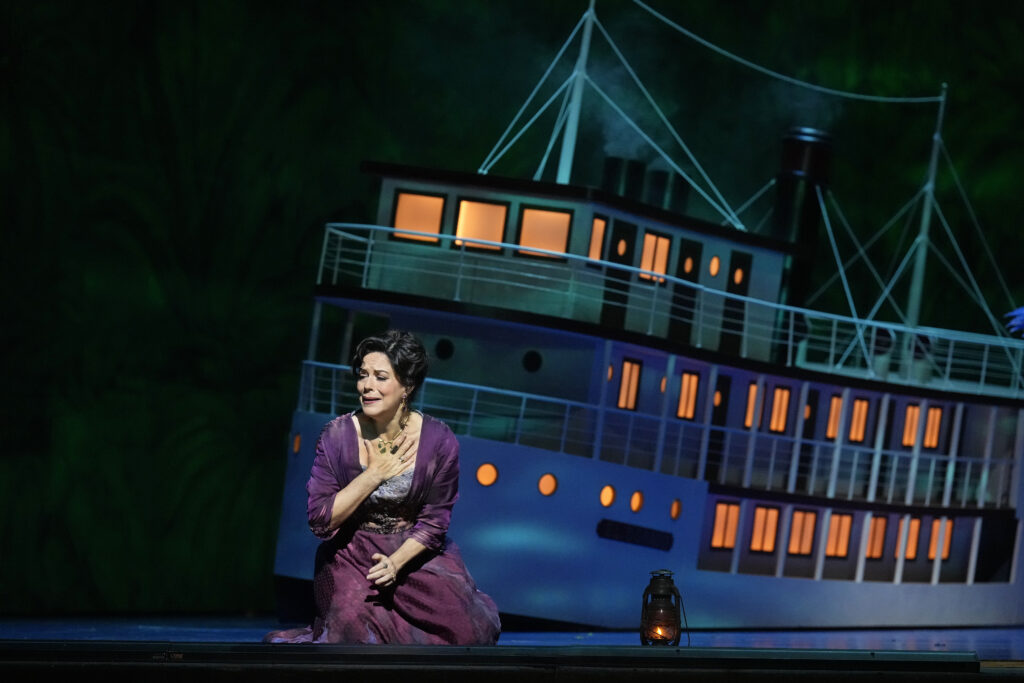
(Credit: Ken Howard)
Flowing Constantly
Daniel Catán’s “Florencia en el Amazonas” opens with a harp glissando into a flurry of alternating sixteenth notes beneath a brilliant brass line. Both components are notable in how they form the backbone of the opera. The alternating sixteenths are impressionistic in style, the motif returning time and again throughout to establish the continuous flow of the Amazon River where the opera takes place. The brass line is, ironically, more crucial in the context of “modern opera” – a romantic melody. It’s brief and eventually shifts into a different mood, but from the off, Catán establishes a language for his opera that will be in constant conflict.
This is particularly effective in the vocal writing and how it expresses character. Florencia gets three distinct monologues / arias throughout the opera. They are the longest solo passages in the opera, each seemingly building on the previous one. And while they are attached to a brief leitmotif, this music shifts and turns in different directions, expressing her endless longing for Cristóbal. It ascends into the highest range of the soprano while also descending low and soft. And while each climaxes, you’re always left feeling like there’s somewhere else it could go. The music leaves you wanting more. Even at the end, after Florencia finishes “Dónde estás, Cristóbal,” capped by a glorious A5, the music slowly expires in a mysterious bliss, cathartic, freeing, yet still longing. The musical language beautifully expresses her emotional journey.
Rosalba, also a soprano, longs to write about Florencia and is on a journey to meet her. As such, Rosalba’s musical language superficially hues closely to her idol’s, but is also quite distinct. We get but few short phrases initially from her, all of them ebullient and full of intense high notes, expressing Rosalba’s seemingly endless energy and free spirit. The music never gets as introspective as Florencia’s until love enters into her life. And yet, it retains that joie de vivre, the youthful intensity. Arcadio, a tenor matches this as well, with similarly soaring lines, always ascending, cementing his desire to fly away.
At the other end of the spectrum are Alvaro and Paula, a baritone and mezzo-soprano who sing rhythmic lines. Unlike the others, they don’t initially get anything approaching melody, emphasizing the decay of their relationship. They constantly sing off of each other or against one another (though ironically, they often mirror one another vocally to emphasize the connection they can’t see). It’s all plain to see when this couple joins with Rosalba and Arcadio for a quartet (I’ll identify it as “Esa es la diferencia” because they repeat this numerous times). While the tenor and soprano coupling engage in long, fluid lines, always reaching upwards, Alvaro and Paula continue with their rhythmic language, providing a beautiful counterpoint of new love versus old love.
But Catán breaks the pattern in Act two. When Alvaro goes missing, Paula gets one of the most gut-wrenching arias in the entire opera. The passage, “¡Alvaro!” allows Paula to unshackle herself from the rhythmic vocal lines from Act one and lets her soar in her vocalism as she proclaims “Alvaro, cariño, quiero estar a tu lado para siempre,” accompanied by arguably the most beautiful melody in the entire opera; this melody reappears moments later when Alvaro reappears, cementing their bond. Then they get a chance at the flowing lyrical lines, together.
Then there is Riolobo and the Captain. The latter, scored for a bass, is grounded and poised, while Riolobo is more fluid in the musical language, not always clear and concise, but constantly shifting like the character.
In the midst of all this, Catán textures the orchestra with a consistent coloring that gives us the feel of the continuous journey and progression. It feels cohesive, slowly, but subtly building on itself.
What struck me most about hearing “Florencia” was that it felt new and familiar all at once. And I think that comes down to Catán’s embrace of opera’s traditions in a modern context. A lot of new works presented at the Met (and I emphasize this because those operas represent but a tiny fraction of what encompasses modern opera at large) seem to determined to establish their “modernity” or “newness” by eschewing the operatic tradition surrounding them, by trying to stand out by being as diametrically opposed to them as possible. The elimination of lyricism in favor of “naturalistic” vocal speech is one thing you often hear and with it, the lack of melodic clarity or development stands out as a major trend. There isn’t anything inherently wrong with that and it can prove effective in instances, but most of the time, and I emphasize that this is how I personally feel, the music seems secondary to the experience. The music seems to follow the text and be part of creating a mood rather than being the central storyteller and commenting or questioning events unfolding. I can recall a style or idea of the music, but I rarely remember said music itself or, admittedly, feel any desire to return to it. More importantly, it often feels that this trend essentially eliminates any possibility of looking backward as a means to go forward. Tradition must be eliminated / ignored for progress to continue. This isn’t a trend related only to opera, by the way, if you listen to a lot of modern film scores. But because of the fact that vocalism is at the core of opera, I think it bears remembering why some of the most beloved operas of all time have stood the test of time.
With “Florencia” you have an opera that embraces opera’s past and wears them openly and adoringly, the romantics as well as the impressionists, with Florencia stating at the end that she feels her lover there with her in her song. As I write this, I still can’t get the music out of my head.
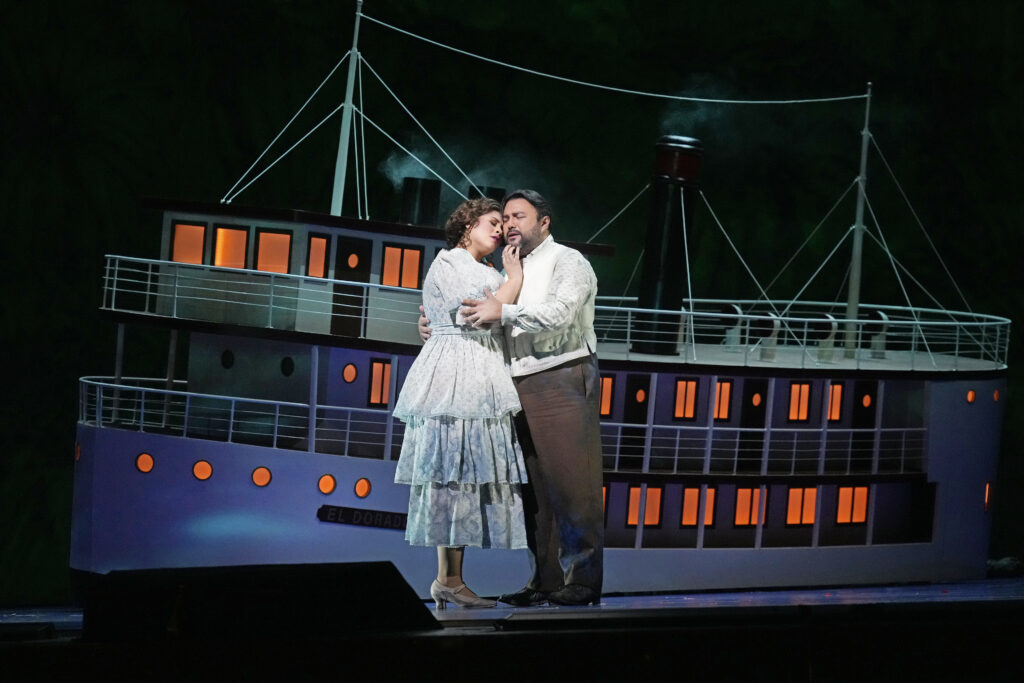
(Credit: Ken Howard)
Great Singers
Also powerful was the cast on hand for the production. As Florencia, Ailyn Pérez was the last of the main performers to appear on stage, but she was the only one to receive a rousing ovation from the audience as she rushed across the stage and up the plank. And she then gifted audiences with a riveting interpretation of “Florencia Gimaldi. No sólo soy mi nombre!” Soft and controlled at the start, Pérez initially suggested a person in control of their destiny. The higher notes of these initial passages were gentle but full of longing, hinting at Florencia’s desire to find Cristóbal. Slowly, the voice took on a more agitated manner as Florencia narrates “Prometí volver” before quieting down yet again for an introspective “Dijiste que me esperarías siempre.” That built up to an even more impassioned lead up to “No solo soy mi nombre,” the high A5 almost weeping as Florencia admits that she could not see herself any longer once she assumed the identity of the diva Florencia Grimaldi. She capped the aria with an impassioned delivery of the brief love motif and a glorious high B5 followed by an even more potent A5 that sent the audience into a rapturous applause.
In Act two, “Cristóbal, Cristóbal,” Pérez’s singing seemed more potent in climaxes and yet softer in the piano sections, creating a more jagged contrast in the music and further emphasizing the character’s increased desperation. This was most noticeable throughout “Sé que estás cerca pero no sé no sé,” Pérez’s voice brilliant on the C5 at the start and apex of the phrase. Contrast that darker and more somber aria with the final one “Dónde estás Cristóbal, full of hope, Pérez’s voice brighter in tone, the lines driving ever-forward, taking flight. “Cristóbal, te siento palpitar en el aire suave de mi canción” was one of the most cathartic and riveting moments of any opera all season, and the final lines of “Aquí, aquí en mi canto” were nothing if not a musical embrace stopping time.
In these solo moments, we were given a window into the torment and then liberation of the central character, which contrasted nicely with the more guarded interactions in other scenes. Even when she’s recognized by the Captain, Pérez’s Florencia maintains her distance and rigid body language. It isn’t until the second half, when the passengers have finally started connecting, that her Florencia took on a more relaxed demeanor, particularly as she jokes about with Gabriela Reyes’ Rosalba. Even then, Pérez never gives us the Florencia we see in those monologues, which emphasizes that conflict the character brings up early on about the public person she doesn’t recognize and the private one she left behind and longs to return to.
As Rosalba, Gabriela Reyes leaned into the effusiveness of her character and her drive for boundless freedom. Her voice retained an intense brightness that truly shone in the numerous high notes she got to sing. She tossed off all of the challenging lines with confidence and joy that added to her character’s intensity. But her meetings with Arcadio hinted at slight hesitation, her singing more gentle and delicate, even darker before the eventual recognition of their love allowed her to return to the initial intensity from the start. Tenor Mario Chang struggled to project in the lower reaches of his voice in the early going, particularly in the initial confrontation with his uncle the Captain over his future. During this passage, the orchestra overpowered him a bit, but when he sang in his upper registers, the voice soared. From then on it was smooth sailing for the tenor with his solo “Yo quiero ser piloto” a particular highlight, the tenor in complete control, each phrase growing in potency, driving the vocal peaks. Particularly beautiful was the piano singing on the final “Y con un simple roce el alba entera incendiar.” He proved a great partner to Reyes, matching her potent sound phrase for phrase, their voices melding together wonderfully.
Nancy Fabiola Herrera’s dark and crude mezzo added a different layer to the vocal coloring of the cast. The jagged quality suggested a woman broken in her relationship, something that she played up with pointed diction and phrasing as she argued with her husband. It’s unfortunate that parter Michael Chioldi, as warm and elegant as his baritone is, was never quite able to match her in that vocal incisiveness. Part of the challenge was that his Spanish diction was lacking and it seemed at times like he was hiding that by focusing on rounding the sound a bit. It hindered the back and forth a bit between them. Nonetheless, it still came across well enough.
Herrera’s shining moment was the aria “¡Alvaro!” where her harsher vocal colors combined with the gentler lyricism allowed for a gut-wrenching portrayal. There was a rawness to the singing, her voice building, the desperation and longing of Paula’s lament crescendoing both musically but also emotionally. When he returned for the opera’s climax, Chioldi’s baritone was allowed its greatest moment, his caressing vocal line matching up with Herrera’s similarly warm timbre.
Both Mattia Olivieri and Greer Grimsley also seemed to struggle with their Spanish diction as well (I don’t think I’ve heard singers struggle much in Italian, German, or French at the Met, though, because of institutional education and programming, those languages get sung a whole lot more) with the latter not particularly comprehensible most of the time. Nonetheless Grimsley’s bass provided a grounding presence and his similarly stoic body language emphasized his character as the motor of the story. His most memorable moment came during that initial confrontation with Mario Chang’s Arcadio where the frantic tenor was met with a caressing vocal response from Grimsley and an assurance that the journey never stops and that life will always have new challenges in store.
Meanwhile Oliveri’s singing was nimble, shifting from fast rhythmic passages to broad vocal lines to the imposing and powerful declamatory “¡Amazonas de este rio! ¡Piedad!” In this moment, Oliveri’s voice boomed into the hall with an imposing yet pleading manner. He’s dressed in gold for this moment and the moment recalls an indigenous ritual in the midst of the big storm. However, because the production does not define Riolobo’s character particularly well, this moment lacks the emotional impact it could have. Often, Riolobo just seems to be there more by requirement than by dramatic interest or development and Oliveri’s often captivating stage presence ultimately doesn’t get much to do. But more on the dramatic execution in a bit.
Finally, Yannick Nézet-Séguin led another captivating performance from the pit. There were moments where balance with the singers and the pit were a bit off and he overpowered the male voices quite a lot throughout the evening. But otherwise, the orchestra sounded glorious, allowing Catán’s musical language to speak freely and clearly. The musical transitions were seamless and the entire tapestry of the piece felt cohesively constructed throughout. The opera is powerful and Nézet-Séguin managed to bring that to the forefront with conviction and prowess.
A Massive Misfire
What wasn’t powerful was Mary Zimmerman’s production.
I already mentioned it in my review of her very fine “Eurydice” a few seasons back, but over the course of now six operatic productions at the Met, Zimmerman is more miss than hit. She belongs to the stable of directors that have been here from the beginning of Peter Gelb’s regime and to whom he returns to time and again even when the results are questionable.
Even though “La Sonnambula” was arguably her most incoherent realization to date, “Florencia” might be her biggest and most unfortunate misfire, given the importance of the occasion.
As you enter the Met, you are met with a green curtain with some patterns depicting a forest setting. It makes sense if a little on-the-nose.
But then things start to fall apart when the curtain rises. A flat screen projecting a shoreline with a bunch of people scattered about. On stage left is a plank leading off-stage setting the scene for the departure of El Dorado. The composition of the stage is flat. From the last of levels (save for the plank) to the background. The costume design by Ana Kuzmanic is solid in setting up the cultural world of the Amazon. And the scene as a whole works in introducing the major players and setting the mood for the story.
But then the curtain lifts and it all falls apart.
We get two large projector walls dividing up the stage, allowing for central area in the middle where most of the action takes place. These walls are bathed in the same green from the opening curtain. The entire time. No variation. No development. No change. Always the same shade of green all the time. The only thing that changes is the projection of subtitles on some very questionably large font that makes it look like a amateur power point presentation. The subtitles appear across the two screens if there are two characters on stage, which forces the viewer to peer across from one screen to the other, almost as if the priority were to read the subtitles. At another point, during Florencia’s first monologue at the start of Act two, some of her lines would appear numerous times across the screens as some sort of splintering effect, an idea that would never be engaged with again. There’s nothing inherently wrong with subtitles on the stage, but usually they are placed in a more discreet location where the viewer can choose to engage with them or not (case in point: Zimmerman’s “Eurydice”). But here, especially given the size and the awkwardness of the font, it was as if Zimmerman and co. were screaming for people to read them, almost saying, “here are some subtitles for a language you probably never heard before!” And that’s just the tip of the iceberg.
Throughout, stage people, dressed as sailors, walk on and off to change or reposition stage scenery. Dancers dressed as a limited amount of the endlessly flora and fauna of the Amazon make appearances throughout, particularly during transitional moments. The opera itself lends itself to this constant shifting around, but things start to feel rather monotonous and thrown together. Transitions become predictable. Singers finish their scenes, then walk off unceremoniously, not letting the scene’s impact linger. Once they are walking off, the “soldiers” bring on the set change, while the dancers distract a bit. Then the next singers come on, rinse and repeat ad nauseum. I already acknowledged this is a possible critique of the opera’s structure, but Zimmerman’s decision to double down on it without any seemingly room for flexibility or creative counterpoint, hinders the experience. I am not a big fan of the overuse of the stage turntable, but never did a production scream more for it than this one.
Then there’s the lack of depth. And I mean that in all ways. What do these flora and fauna dancers mean outside of the obvious “let’s incorporate magical realism in a magical realism opera?” I think it’s a brilliant idea, on the surface. But it’s always the same animals, same costumes, same guy walking by with the same crocodile puppet. There are over three million species in the Amazon rainforest and they could only think to settle on less than 10, if that? It comes off as half-baked because there was an opportunity for the design, as the characters get closer to Manaus and closer to their destiny for the color scheme of the animals and, yes, the green projections to shift and evolve. Or for the sets to have more dynamic shapes. With a flat stage and a lack of vertical depth, there’s no opportunity to play with unique stage compositions that explore the dynamics of the characters. The climax of Act one with the crash looks clumsy and thrown together due to the reliance of the limited tools. The miniatures and the large butterfly that drops down at one point over the set also feel like last-minute ideas for something that could have been more fleshed out and better incorporated into the entire design. Moreover, the choreography comes off as sloppy in areas because of how crammed everything looks on stage. Only a few times at the end was there any kind of progression or dynamism. The appearance of cholera changes the colors briefly and the railings explore the possibility of the characters being locked away from their destination. There’s also a rain of papers, in which everyone helps picking up the pages of Rosalba’s book. But otherwise it all feels like the same visuals with minimal variations for two hours with the singers not given much to interact with. You could tell there were plenty of interesting ideas at play here, but they never seemed to get a chance to fully develop. It ultimately feels like a rushed, haphazard, and superficial enterprise.
But even that can’t dampen the enthusiasm I have for finally seeing a Spanish-language opera on the Met stage. When Catán wrote this opera in the mid-1990s, he was tasked with the unenviable task of being the first Latin American composer to get a shot to prove himself on a U.S. opera stage. He was essentially the face for an entire region of cultures that weren’t necessarily his to represent (Latin Americans are not a monolith but a group of different cultures and people), a common misconception of a lot U.S. Americans. And he ultimately embraced the task by creating a love letter to that vast region and an art form. A love letter than still resonates to this day, not only because it has become the most performed Spanish-language opera composed in the last few decades or has made it to the Met stage, but also in how it stands out amidst the trends of modern opera that audiences experience now. It feels like a quintessential opera, both new and old at once. Despite the production’s shortcomings, this is still an essential operatic experience during the 2023-24 season.

